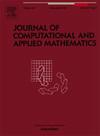Numerical computational technique for solving Volterra integro-differential equations of the third kind using meshless collocation method
IF 2.1
2区 数学
Q1 MATHEMATICS, APPLIED
Journal of Computational and Applied Mathematics
Pub Date : 2024-10-02
DOI:10.1016/j.cam.2024.116294
引用次数: 0
Abstract
The primary goal of this study is to give an approximate algorithm for solving Volterra integro-differential equations (VIDEs) of the third kind using meshless collocation techniques. The basic framework of the novel approach is based on a collocation scheme and radial basis functions (RBFs) created on scattered points. This technique requires no background approximation cells, and the algorithm is powerful, has greater stability, and does not require much computer memory. This approach represents the solution of VIDEs of the third kind by interpolating the RBFs based on the Gauss–Legendre quadrature formula. The problem is reduced to a system of algebraic equations that can be easily solved. A description of the technique for the proposed equations is provided. Furthermore, the error analysis of this scheme is examined. A few numerical experiments are presented to prove the reliability and precision of the suggested approach for solving VIDEs of the third kind. Certain problems were compared with analytical solutions, the moving least squares method, and other methods to prove the effectiveness and applicability of the approach described.
利用无网格配置法求解 Volterra 第三类积分微分方程的数值计算技术
本研究的主要目的是给出一种近似算法,利用无网格配位技术求解第三类 Volterra 积分微分方程 (VIDE)。这种新方法的基本框架基于配位方案和在散点上创建的径向基函数 (RBF)。这种技术不需要背景近似单元,算法功能强大,稳定性更高,而且不需要太多的计算机内存。这种方法通过基于高斯-列根德正交公式的 RBFs 插值来表示第三类 VIDE 的求解。问题被简化为一个代数方程系统,可以轻松求解。本文对拟议方程的技术进行了描述。此外,还研究了该方案的误差分析。为了证明所建议的第三类 VIDE 求解方法的可靠性和精确性,介绍了一些数值实验。将某些问题与分析解法、移动最小二乘法和其他方法进行了比较,以证明所述方法的有效性和适用性。
本文章由计算机程序翻译,如有差异,请以英文原文为准。
求助全文
约1分钟内获得全文
求助全文
来源期刊
CiteScore
5.40
自引率
4.20%
发文量
437
审稿时长
3.0 months
期刊介绍:
The Journal of Computational and Applied Mathematics publishes original papers of high scientific value in all areas of computational and applied mathematics. The main interest of the Journal is in papers that describe and analyze new computational techniques for solving scientific or engineering problems. Also the improved analysis, including the effectiveness and applicability, of existing methods and algorithms is of importance. The computational efficiency (e.g. the convergence, stability, accuracy, ...) should be proved and illustrated by nontrivial numerical examples. Papers describing only variants of existing methods, without adding significant new computational properties are not of interest.
The audience consists of: applied mathematicians, numerical analysts, computational scientists and engineers.

 求助内容:
求助内容: 应助结果提醒方式:
应助结果提醒方式:


